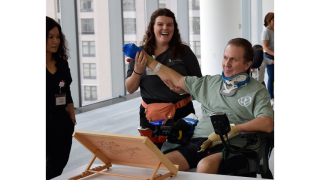Objective
Rehabilitative exercise aims to engage residual neural networks in humans with spinal cord injury to improve functional recovery. In our recent studies, we combined exercise with noninvasive stimulation targeting spinal synapses further promotes functional recovery. In the current protocol, individuals with chronic incomplete spinal cord injury participate 40 sessions of exercise combined with paired corticospinal-motoneuronal stimulation (PCMS). During PCMS, stimuli are timed to have corticospinal volleys evoked by transcranial magnetic stimulation over the primary motor cortex arrive at corticospinal-motoneuronal synapses of upper- and lower-limb muscles before antidromic potentials were elicited in motoneurons by electrical stimulation of peripheral nerve. Participants exercise for about 1 hour after stimulation. Our previous study using similar protocol for 10 sessions showed improvements in physiological and functional outcomes that preserved for at least 6 months after the intervention, which suggests that targeted noninvasive stimulation of spinal synapses might represent an effective strategy to facilitate exercise-mediated recovery in humans with spinal cord injury.
Who Can Participate
Anyone with a chronic spinal cord injury (at least 6 months post injury), levels C1-L4.
Compensation
If interested, please reach out to hjo@sralab.org for compensation and study details!
Age Range
18-80



